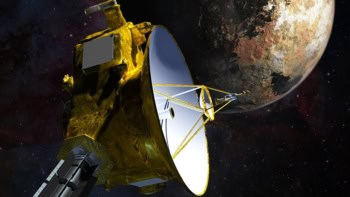A team of Japanese and American physicists claim to have found evidence that neutrinos have mass. Experiments at the Super-Kamiokande detector in Japan suggest a neutrino mass of 0.07 electron volts - less than one millionth of the mass of the electron. The results, presented today at the Neutrino 98 conference in Japan, have immense significance for particle physics and cosmology. However, recent budget cuts could lead to the experiment, which currently runs all year round, being closed down for two months of the year. The Super-Kamiokande collaboration say that such a closure would have a "devastating impact" on research at the facility.
Neutrinos come in three types – electron neutrinos, muon neutrinos and tau neutrinos – and only interact very weakly with matter, which makes them extremely difficult to detect. Neutrino detectors have to be built underground to isolate them from cosmic rays. Even then natural radioactivity from the detector itself can mimic a neutrino interaction, so the detector must be made from ultrapure materials and isolated from its surroundings. The Super-Kamiokande experiment consists of 50, 000 tons of ultrapure water in a tank 1000 metres below ground in central Japan. It can detect both electron neutrinos and muon neutrinos – but not tau neutrinos – from the faint flashes of light given off when they interact with electrons in the water molecules.
According to the Standard Model of particle physics neutrinos have zero mass. However, experiments to measure neutrinos from the Sun and atmospheric neutrinos – produced when cosmic-rays interact with nuclei in the Earth’s atmosphere – detect fewer of these elusive particles than predicted. One possibility is that electron neutrinos can ‘oscillate’ into muon and tau neutrinos, and vice versa. However, this is only possible if neutrinos have mass. A non-zero neutrino mass could also explain some of the ‘missing mass’ in the universe.
Super-Kamiokande has found evidence for oscillations, and hence mass, in atmospheric neutrinos. Data from Super-Kamiokande show that more muon neutrinos enter the detector from above than below. Neutrinos entering from above would have travelled only tens of kilometres through the atmosphere, while those from below would have also had to travel through the Earth. The Super-Kamiokande team claim that the muon neutrinos oscillate into tau neutrinos – or, possibly, a new type of ‘sterile’ neutrino – on their journey through the Earth. “One only gets such great data once or twice in a professional lifetime, maybe never, ” says John Learned of the University of Hawaii, one of the Super-Kamiokande team.
However, the future success of Super-Kamiokande could be compromised by the recent financial turmoil in Japan. The government cut the experiment’s budget by 15 per cent this year, and another 15 per cent is scheduled for next year. If imposed this second cut will force the laboratory to close down for part of the year. Physicists at Neutrino 98 are appealing for extra funding to ensure continuous operation for the experiment. “Budget cuts … jeopardise the strength of the international collaboration and could result in the loss of important observations, such as a rare supernova event, ” they say.



